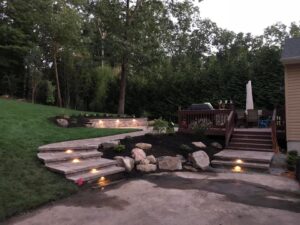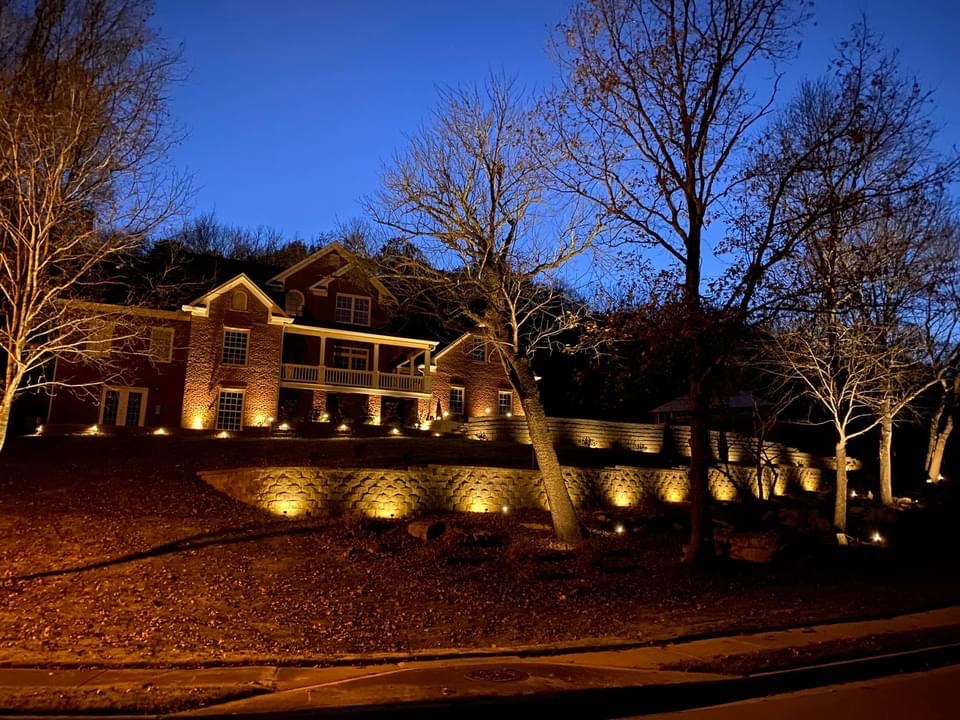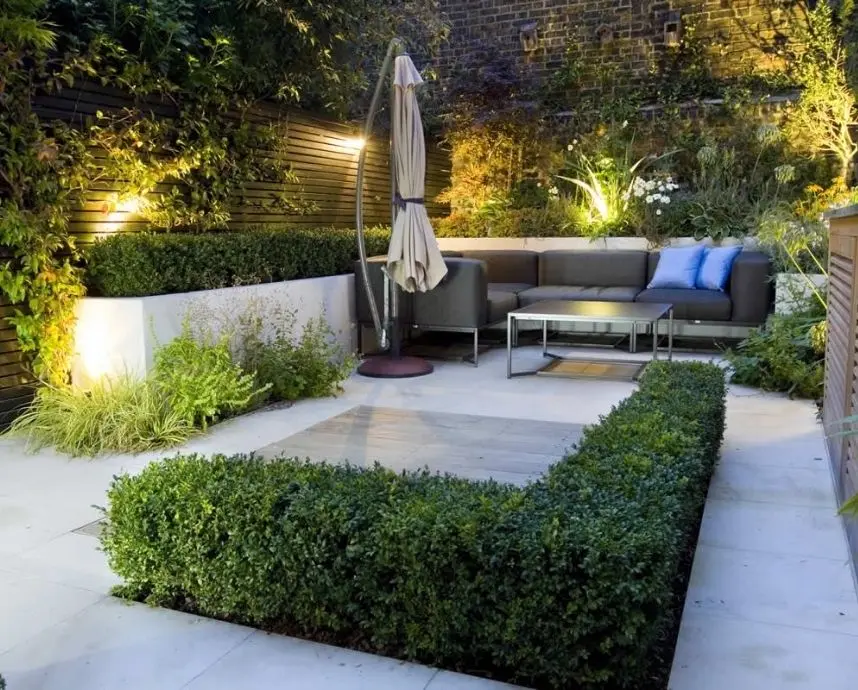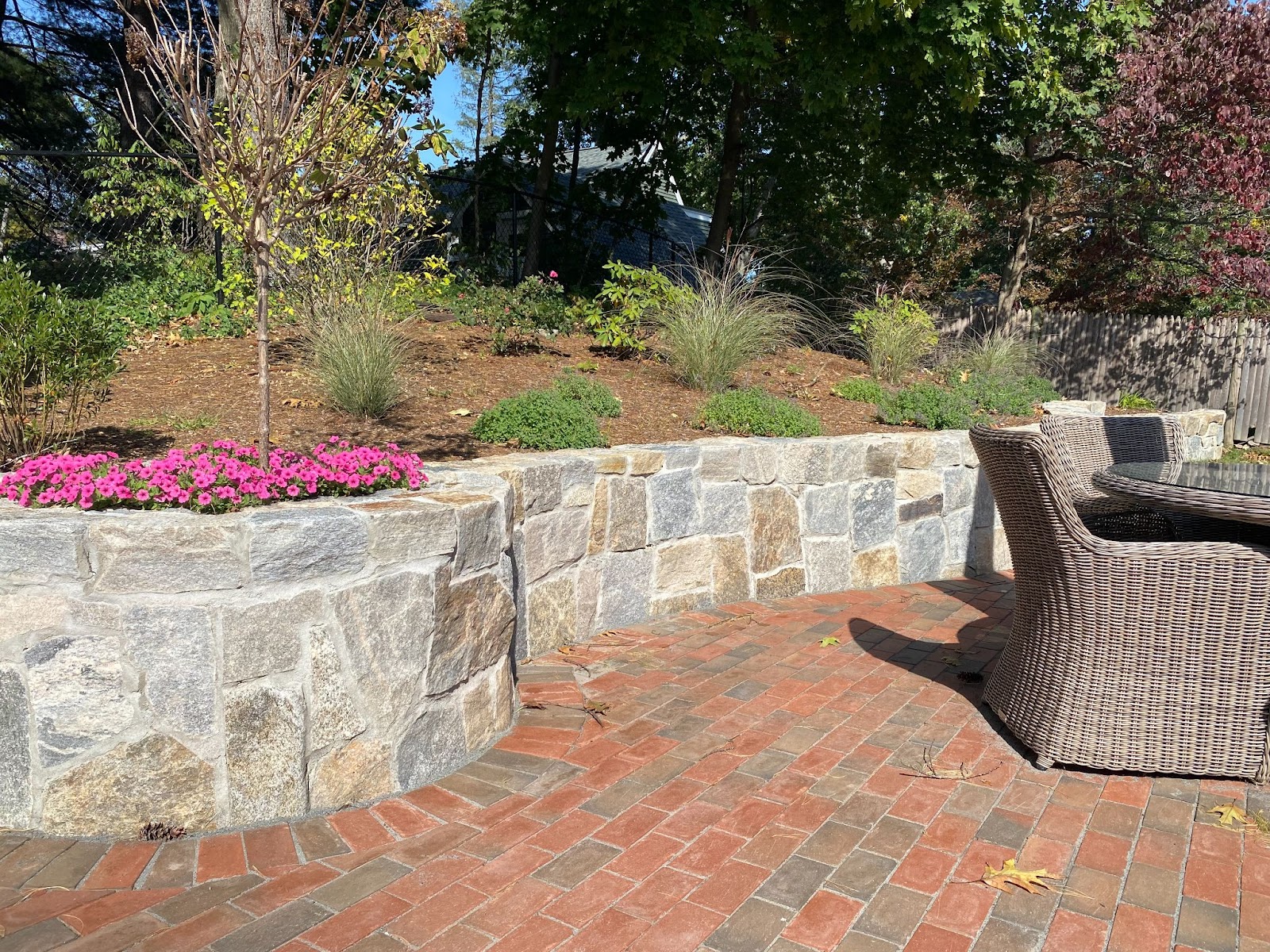Landscape Lighting: It’s not just about making your garden or walkway visible at night. It’s about transforming your outdoor space into a magical, welcoming place, ideal for gatherings or a peaceful evening alone. A landscape lighting designer blends art and science to highlight your home’s architectural features and draw attention to prized plantings, all while improving safety and security.
- Outdoor Illumination: Beyond functionality, well-designed outdoor lighting adds a dramatic flair to your landscape, enhancing the overall aesthetics of your home.
- Aesthetics: Strategic placement of lights can create enchanting shadows, highlight focal points, and set the mood for outdoor activities.
- Safety/Security: From illuminating walkways to deterring trespassers, the right lighting provides peace of mind and ensures your property is navigable and secure at night.
Whether you’re looking to highlight your garden’s best features, extend your living space outdoors, or improve your property’s safety, a landscape lighting designer can bring your vision to life. By considering the blend of aesthetics, functionality, and security, you can transform your outdoor space into something truly extraordinary.

Planning From Your Landscape Lighting Designer
When you start thinking about adding lights to your outdoor space, it can feel a bit like a puzzle. Where do you begin? What do you need? How do you make sure it all works together? Let’s break it down into simpler pieces: Decide Areas, Lighting Techniques, Fixture Selection, Power Supply, Bulb Choice. This way, planning your landscape lighting becomes manageable and even fun.
Decide Areas
First things first, you need to decide which areas of your yard you want to light up. Do you have a path that needs lighting for safety? Or maybe you have a beautiful garden you want to show off even at night? Make a list of all the spots you want to illuminate. This will be your roadmap.
Lighting Techniques
Next, think about how you want each area to feel. Different lighting techniques can create different moods. For example:
- Uplighting can make trees or architectural features stand out.
- Path lighting provides a welcoming guide along walkways.
- Moonlighting creates a soft, natural glow, like the light of a full moon.
Each technique has its own impact, so choose the ones that match your vision.
Fixture Selection
Now, it’s time to pick your fixtures. There’s a wide variety out there, from sleek modern designs to more traditional looks. The fixture should match not only the style of your space but also the job it needs to do. Spotlights are great for highlighting, while path lights should be lower to the ground.
Power Supply
Consider how you’ll power your lights. Low-voltage systems are popular because they’re safer and easier to install than standard electrical systems. Solar-powered lights are another great option, especially in sunny areas. They’re easy to install and have no running costs.
Bulb Choice
Finally, think about the bulbs. LED bulbs are a fantastic choice for outdoor lighting. They’re energy-efficient, long-lasting, and come in a range of colors and brightness levels. The color of the light can greatly affect the ambiance. Soft yellow lights (around 2700 Kelvin) create a warm, welcoming feel, perfect for most outdoor areas.
When planning your landscape lighting, take it step by step. With a bit of thought and creativity, you can create an outdoor space that’s beautiful, safe, and welcoming at night. And remember, if you ever feel stuck, a professional landscape lighting designer can always help bring your vision to life. They have the experience to suggest ideas and solutions you might not have considered.
For more detailed guidance on designing your landscape lighting, check out this informative piece: How do I design landscape lighting?.
By keeping these key points in mind, you’ll be well on your way to creating a stunning outdoor space that shines, night after night.
Designing Outdoor Lighting
When diving into outdoor lighting, understanding the purpose behind your design is the first step. Whether you’re aiming to enhance security, set a mood for evening gatherings, or highlight architectural features, each goal will influence the choices you make moving forward.
Purpose
Every light in your landscape design serves a purpose. Start by identifying areas that need illumination for safety, like walkways and steps. Consider which features you want to showcase, such as a garden or water feature.
Lighting Type
Choose between various lighting types to match your needs:
– LEDs for energy efficiency,
– Solar-powered lights for ease of installation,
– Halogen for brighter, more focused light.
Brightness
The brightness, measured in lumens, should align with the purpose of the lighting. Pathways need softer lighting compared to a spotlight on a statue. Outdoor lighting is not about creating daylight at night but about enhancing the night-time environment.
Night Mode
Utilizing a “Night Mode” feature can revolutionize your design process. By visualizing how your space looks in the dark, you can accurately place lights where they are most effective. This approach ensures that areas needing illumination are covered, and the beauty of your landscape is enhanced after sundown.
My Design Tool
Leverage tools like “My Design” to streamline the design process. This tool allows you to upload photos of your outdoor space and experiment with different lighting placements and styles. You can see in real-time how various fixtures affect the ambiance and functionality of your area. It’s a game-changer for anyone looking to create a professional lighting design without the guesswork.
By integrating these elements into your design process, you’ll craft an outdoor lighting scheme that not only meets your aesthetic and functional needs but also transforms your space into a nighttime oasis. The goal is to enhance, not overpower, your landscape’s natural beauty. For a deeper dive into crafting the perfect lighting design, check out this helpful resource: How do I design landscape lighting?.
Keep these considerations in mind to ensure your outdoor lighting project shines in the best light possible.
Profit Margins and Business Considerations
When stepping into the realm of landscape lighting design, understanding the business side is as crucial as the creative one. Let’s break down some key factors: Increased Demand, Gross Profit Margins, Investment in Training, and Equipment Minimal.
Increased Demand
First off, the demand for landscape lighting has been on a rise. More homeowners and businesses want to beautify their outdoor spaces, enhance security, and extend their usable hours after sunset. This growing interest presents a fertile ground for landscape lighting designers to expand their services and clientele.
Gross Profit Margins
Profit margins in landscape lighting can be quite attractive. Given that the initial costs—mainly equipment and training—are relatively low, the return on investment can be significant. A well-executed project not only adds value to the property but also to your portfolio, leading to more referrals and higher demand.
Investment in Training
Investing in training is a key factor for success in this field. Knowledge about the latest technologies, design principles, and installation techniques is paramount. As cited by a Reddit user, free landscape lighting design classes offered by manufacturers like Hunter (FX Luminaire) can be invaluable . This education enhances your skill set, making your service more desirable to potential clients.
Equipment Minimal
One of the appealing aspects of starting or growing a landscape lighting business is the minimal equipment required. The basic tools for installation are straightforward and affordable. Plus, as LED technology advances, the cost of high-quality lighting fixtures is decreasing, making it easier to deliver stunning results on a variety of budgets.
In essence, stepping into or expanding within the landscape lighting sector is a smart move. With a bit of investment in training and some basic equipment, you can tap into a market that’s not only lucrative but also creatively rewarding. As you plan your projects, the goal is to illuminate beautifully, enhancing the natural charm of each outdoor space.

Popular Landscape Lighting Designs
When diving into landscape lighting, it’s important to understand that the design you choose can dramatically transform your outdoor space. A landscape lighting designer can bring your garden to life after sunset, highlighting its best features and making it usable at night. Let’s explore some popular designs that could make your outdoor area shine.
Path Lighting
Path lighting is all about safety and aesthetics. It involves placing lights along walkways, driveways, or garden paths to guide visitors safely while adding a charming ambiance. Simple yet effective, path lighting ensures no one will stumble in the dark and creates a welcoming path into your home or garden.
Patio Lighting
Your patio is a hub for evening social gatherings, and the right lighting can make it a cozy, inviting space. Soft, diffused lighting works wonders here, often achieved with string lights or well-placed lanterns. It’s not just about visibility; it’s about creating a mood that makes evenings on the patio something to look forward to.
Tree Uplighting
Trees are majestic during the day and can be equally dramatic at night with uplighting. Placing lights at the base and angling them upward can highlight the intricate patterns of branches and leaves, casting beautiful shadows and transforming trees into nighttime focal points.
Water Features
Water and light are a magical combination. Whether it’s a pool, fountain, or pond, lighting water features can elevate the ambience of your outdoor space. The way light plays off moving water adds a dynamic, sparkling effect that’s both mesmerizing and tranquil.
Architectural Elements
Don’t let your home’s architectural beauty fade into the night. Strategic lighting can accentuate interesting architectural details, textures, or colors. It’s about creating depth and contrast, making your home’s design elements stand out against the night sky.
Driveways
Though often overlooked, driveways can benefit significantly from good lighting. It’s not just practical for safety; it’s also an opportunity to make a strong first impression. Lighting can guide guests to your home and highlight the landscaping along the drive, making the journey to your door an experience in itself.
Incorporating these designs into your landscape lighting designer plan requires a thoughtful approach. A landscape lighting designer can help you navigate the choices, ensuring that each element of your outdoor space is considered and beautifully illuminated. Whether it’s creating a path of light to your front door or casting a glow on a serene water feature, the right lighting design can transform your property into a nighttime masterpiece.
For those looking to dive deeper into landscape lighting designs and see examples of how they enhance outdoor spaces, this source offers great insights and inspiration.
Landscape Lighting Techniques
When you’re planning the outdoor lighting for your property, understanding different landscape lighting techniques is key. These techniques can highlight your home’s features, enhance safety, and create a magical atmosphere after the sun goes down. Let’s dive into some popular methods used by landscape lighting designers.
Uplighting
This technique involves placing lights at ground level, pointing upwards. It’s perfect for showcasing trees, architectural details, or any vertical structures. Uplighting adds drama and is a fantastic way to draw attention to the beautiful features of your home or garden.
Moonlighting
Imagine the soft, natural glow of moonlight casting shadows through tree branches. That’s the effect moonlighting aims to replicate. By installing lights high up in trees and angling them downwards, you can create a serene and natural ambiance. It’s subtle but can add depth and character to your outdoor space.
Silhouetting
Silhouetting is all about creating striking outlines. Place a light source behind an object, like a plant or statue, and shine it towards a backdrop like a wall. This technique creates a silhouette effect, highlighting the shape of the object against the light. It’s a simple way to add visual interest and drama.
Shadowing
The opposite of silhouetting, shadowing projects the shadow of an object onto a surface. By placing the light in front of the object and pointing it towards a wall or fence, you can cast intriguing shadows. This technique works well with plants and trees, adding movement and depth as leaves and branches sway in the breeze.
Path Lighting
Safety meets aesthetics with path lighting. This technique involves placing lights along walkways, driveways, or garden paths. It ensures safe passage by illuminating steps and potential obstacles, all while adding a welcoming glow. Path lighting fixtures are typically low to the ground and spread out to create an even, guiding light.
Each of these techniques offers a unique way to enhance your outdoor space. By combining them, a landscape lighting designer can create a layered and dynamic lighting plan that highlights the best features of your property, improves safety, and sets the perfect mood for your outdoor areas after dark.
For those interested in exploring more about how these techniques can be implemented in various outdoor spaces, this source provides further insights and examples.
Next, we’ll dive into installation tips and tricks to ensure your landscape lighting not only looks stunning but is also functional and durable.
Installation Tips and Tricks
Getting your landscape lighting right involves more than just picking out pretty fixtures. It’s about planning, precision, and understanding the flow of electricity. Let’s break down the essentials.
Sketching Your Property
Start with a simple sketch of your property. This doesn’t have to be a masterpiece, but it should accurately reflect the layout of your outdoor space. Mark where you want your lights to go. Think about the paths, garden beds, architectural features, and any dark spots that need illumination.
Choosing a Transformer Location
Your transformer is the heart of your landscape lighting system. Place it close to your home and near a power source, but hidden from direct view if possible. It needs to be at least 12″ off the ground if outside.
Fixture Locations
Use your sketch to mark the exact spots for your fixtures. Walk around your property with flags or markers to visualize where each light will go. This will give you a better sense of the space and how the lights will interact with their surroundings.
Planning Wire Runs
Now, think about how to connect everything. Running individual wires from each light back to the transformer wastes wire and money. Instead, use one of these methods:
- Daisy Chain: This is the simplest method, where you connect each light directly to the next one in a single line. While easy, it can lead to voltage drop issues if your chain is too long.
- T-Method: This involves running a main wire from the transformer and then connecting each light or group of lights to it with a “T” junction. It’s more efficient than daisy chaining and reduces the risk of voltage drop.
- Hub Method: This is the most reliable method. You run a main cable from the transformer to a central hub, and then connect each light to the hub with its own wire. This method ensures each light receives the same voltage, preventing dim lights at the end of the chain.
- Combination Method: Sometimes, one method won’t fit all parts of your property. Feel free to mix and match these techniques as needed to suit different areas.
Final Tips
- Always choose high-quality fixtures and transformers. They’ll be exposed to the elements, so durability matters.
- Consider the future. Leave a little slack in your cables and document your installation. This makes maintenance or adjustments easier down the line.
- Voltage drop is a real issue. Use a voltage meter to check the power at each fixture. If there’s a significant drop, you may need to adjust your wiring plan.
Landscape lighting installation doesn’t have to be daunting. With a bit of planning and the right techniques, you can illuminate your outdoor space beautifully and efficiently. A well-lit landscape not only enhances the beauty of your home but also improves safety and security.
For those embarking on their first landscape lighting project, this guide offers a solid foundation. And if you’re looking for more detailed advice or specific examples, this source is a great place to start.

Frequently Asked Questions about Landscape Lighting
Embarking on a landscape lighting project brings up many questions. Let’s tackle some of the most common queries to help guide your decisions.
How far apart should landscape lights be?
Path lights should ideally be placed about 6 feet apart. This distance ensures an even spread of light, reducing shadows while maintaining a visually appealing setup. However, this can vary based on the light spread of your specific fixtures and the path’s width.
What is the best color for landscape lighting?
When it comes to color temperature, 2700 Kelvin is often preferred. This color temperature emits a soft yellow light, creating a warm, welcoming ambiance. It’s bright enough to light your way without overpowering the natural nighttime atmosphere.
Do LED landscape lights need a special transformer?
Yes and no. LED lights operate on low voltage (12 volts), just like many traditional landscape lights. However, because LEDs consume less power, the transformer’s wattage rating might differ. It’s essential to ensure your transformer can handle the total wattage of all connected lights plus a 10-20% buffer to prevent overloading. For high-voltage systems, a specific transformer designed for LED compatibility is necessary to convert your home’s 120-volt supply to the 12-volt requirement of most LED fixtures.
Remember, consulting with a landscape lighting designer can provide personalized insights and recommendations for your project. They can help determine the best spacing for your lights, the optimal color temperature for your space, and whether your current transformer is up to the task or if you’ll need a new one.
For more detailed guidance or to dive deeper into landscape lighting, reaching out to a professional, like those at JM Mento Landscape Design, can illuminate the path to a beautifully lit outdoor space tailored to your needs and preferences.
Conclusion
In wrapping up our journey through the enchanting world of landscape lighting, it’s clear that the right illumination can transform any outdoor space into a magical, welcoming environment. At JM Mento Landscape Design, we pride ourselves on being more than just a service provider; we are your partner in bringing to life the outdoor living solution of your dreams. Our one-stop shopping approach ensures that from the initial concept to the final installation, every aspect of your landscape lighting project is handled with expert care and attention.
Why Choose Us?
- Expertise: As seasoned landscape lighting designers, we possess the knowledge and skills to enhance the beauty, safety, and functionality of your outdoor areas.
- Customization: Understanding that each space is unique, we offer tailored solutions to meet your specific needs and preferences.
- Quality: We use only high-quality fixtures and materials to ensure the longevity and performance of your lighting system.
- Convenience: Our comprehensive service package means you won’t have to juggle multiple contractors. From design to installation, we’ve got you covered.
- Customer Satisfaction: At the heart of our business is a commitment to ensuring you are delighted with your outdoor lighting project. Your satisfaction is our top priority.
Whether you’re looking to highlight architectural features, create a cozy atmosphere for outdoor gatherings, or enhance the security of your property, our team at JM Mento Landscape Design is equipped to bring your vision to light. Our blend of creativity, technical knowledge, and dedication to excellence ensures that your outdoor spaces will not only shine but also reflect the beauty and character of your home.
Embark on Your Landscape Lighting Journey
Ready to illuminate your outdoor space with stunning landscape lighting? Visit our service page to learn more about how we can transform your property into a nighttime oasis.
Together, let’s create an outdoor environment that you and your loved ones will enjoy for years to come. At JM Mento Landscape Design, we believe in making every outdoor moment beautiful, safe, and memorable.






0 Comments